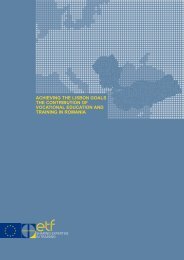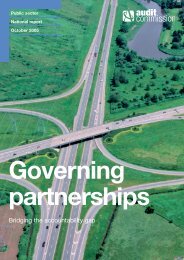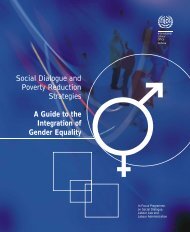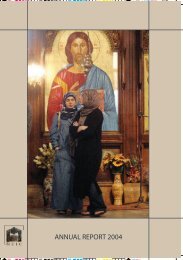PDF (508 KB)
PDF (508 KB)
PDF (508 KB)
Create successful ePaper yourself
Turn your PDF publications into a flip-book with our unique Google optimized e-Paper software.
SUSTAINABLE GROW TH IN VÄRML AND 1Sustainable growth in VärmlandNational Commission for Regional EmpowermentSustainable Growth in Värmland is the Regional Growth Programme (RGP) for Värmland.The programme is valid from 2004 to 2007.The initiative to create a regional growth plan for each county came from the government,which has also drawn up general guidelines for the project. The initiative is, in turn, basedon the Swedish Parliamentʼs document on new regional development policiesThe point of departure for our work in Värmland has been the realisation that we havemajor challenges ahead of us and need to make the best of our present situation and theassets we have in the county. If we succeed, then Värmland will make a positive contributionto the overall situation in Sweden. A prerequisite for success is that additional investmentbe made in the form of infrastructure and other basic resources required for growth, suchas Karlstad University.The regional growth programme covers a broad area and is a strategic document presentingwhat in our view are important pre-requisites for “Sustainable Growth in Värmland”.The programme is broader than other programmes, such as the EU Structural fundprogrammes and is an umbrella under which most our efforts are collected.Widespread SupportThe formal mandate to set up a regional growth programme was given to the County AdministrativeBoard. In practice, the work has been carried out in close co-operation with RegionVärmland which has been equally responsible for the creation of the programme.Work on the regional growth programme was initiated during the annual VärmlandConvention (a broad partnership meeting for an open dialogue) 1–2 October 2002. TheConvention confirmed the importance of widespread support for the programme.For this reason, more than 100 people from more than 70 different organisations participatedin the main programme. In addition, extensive information was distributed andparticipation encouraged from different groups and networks.The county presented a programme proposal to the government on 1 October 2002.On 18 December 2003, the government gave its approval.Following approval, work on a plan of action involving five workings groups (see below)was commenced. The main goal of the action plan was to specify and clarify the aims ofthe programme. The groups were encouraged to initiate broad dialogues during their workand altogether nearly 200 people have been more or less involved.The annual Värmland Convention on 30 March 2004 was used to further secure broadsupport for the programme.Great efforts have been made to ensure the equal participation of men and women inthe various working groups and to encourage the participation of people from all parts ofthe county as well as people with diverse competencies.Both the County Administrative Board and Region Värmland have approved the programme.
2 SUSTAINABLE GROW TH IN VÄRML ANDOverall goals –Sustainable Growth in VärmlandBy “Sustainable Growth in Värmland”, we mean increased growthin Värmland which is sustainable from a social, economic andecological perspective. It is such development that we strive forand hope to achieve with this programme.One goal of “Sustainable Growth in Värmland” is that our industry will be able to competein an increasingly global economy. We see social and environmental issues as drivingforces and opportunities for sustainable growth.We believe that actively working with issues of gender creates a potential for sustainablegrowth in Värmland. In the same way, efforts to strengthen social unity in the countycontribute to sustainable growth in Värmland.Social exclusion through unemployment and sickness will be counteracted. A shared goalis a high level of public health. Our exploitation of natural resources and energy will be effectiveand impacts on the environment minimised. Our ecological footprint will be limited.In order to achieve the overall goal, our ambitions and intentions are defined in five priorityareas and fifteen strategies.LeadershipWe want Värmland to focus on the leadership required to concentrate resourceson important strategies.Strategies include: Strategic leadership for co-operation, Inter-regional cooperation,Creating a strong profile for Värmland and Strategic alliances.CompetenceWe will raise the level of education in Värmland to match the future requirementsof industry. This means liberating the inherent resources representedby the diverse population of Värmland and developing an R&D-basedinnovation force.Strategies include: Providing competence, Research and developmentand Utilising the diversity of the population as a resource.Physical and Social EnvironmentOur ambition here is that the population of Värmland should increaseprimarily through immigration to the region but also by encouraging thecurrent population to stay. The people of Värmland should become healthierthrough the efforts to stimulate a stronger social climate.Strategies include: Attractive physical and social environment, Publichealth development and Local development.
SUSTAINABLE GROW TH IN VÄRML AND 3Relationship analysis. The most important direct relationships between strategies are markedwith arrows.MobilityOur ambition is to improve infrastructure, thus enabling the people of Värmlandto study or work where they want to, and at the same time satisfyingthe growing competence needs of companies.Strategies include: Accessible infrastructure.IndustryOur ambition is to increase the competitiveness of industry in Värmland andalso increase the number of enterprises. We focus on a knowledge-drivenindustry and measures that support innovation. Increased support for theeffective use of energy is required.Strategies include: Cluster development, Entrepreneurship, Culture andevent marketing and management, and Environment and ecology.
4 HÅLLBAR VÄRMLÄNDSK VÄXTKRAFTAnalysis of TrendsAs our point of departure, we recognise that the rest of the world sets the tone for our workon the programme for Sustainable Growth in Värmland. Our analysis has identified trendsthat occur in the rest of the world but have clear consequences for Värmland. We havedefined trends that are external phenomena or are changes in attitudes and values.In our work, we identified 75 trends that are related to sustainable growth (economic,ecological and social) in Värmland in the period up to 2010. These 75 trends were thenImportant trends and the relationships between them. The trends we identified are dependent on eachother. We have collected our analyses of these dependencies in the following way.
SUSTAINABLE GROW TH IN VÄRML AND 5summarised in the 21 trends that are presented in the programme. These trendsare grouped under the following headings:Increased internationalisationIncreased individualisationAgeing PopulationClearer environmental requirementsConcern for a higher standard of livingIncreased importance of competenceIncreased focus on companies and businessIncreased mobilityIncreased co-operationImportant AssetsOur analyses have also focused on important assets in the county. We have presented theseassets in the form of an illustration - The Tree of Assets. The tree draws nourishment fromthe soil. The assets that the soil represents should be seen as the basic requirements forgrowth. These assets are not particularly unique and are present almost everywhere. Atthe same time, it cannot be taken for granted that they are present everywhere and all thetime. The higher up the tree we come, the more advantageous and unique our assets are.4
6 SUSTAINABLE GROW TH IN VÄRML AND4 Important AssetsThe Paper Province is a unique cluster of forest-industry companies spreadacross the counties of Värmland and Dalsland. Predominantly an area of pulp andpaper manufacturing, the region consists of small and medium-sized companies aswell as international giants. There are 10 000 employees in 170 companies. Keyresearch and development features strongly in this internationally unique cluster.Compare IT is a cluster of industrial information technology companies consisting ofapproximately 100 companies with 5 000 employees.The engineering and steel industry employs about 11 000 people. Mostcompanies work in the engineering sector and a few represent the steel industry.The environmental industry covers environmentalmanagement, environmentally adapted product developmentand environment and energy technology. Sustainabletourism means that Värmland must take care of its natural assets.The food and provisions industry does not really constitute acluster, but it does represent important companies and brand names, both nationaland international.The number of self-employed people in the county is substantial with the highestconcentration in the west of the region. Several organisations are in place to help newentrepreneurs and small businesses establish themselves in the business environment.Physical infrastructure is an important prerequisite for growth. Värmland is situatedin the strategically attractive corridor of growth between the two capital cities ofStockholm and Oslo, and is therefore included in the European transport network.Education and research are possibly the most important strategic resources for thedevelopment of local industry and the employment market. In this respect, KarlstadUniversity is a major component.The Värmland culture and event management industry offers a host of products,with everything from the traditional Värmland culture and story telling tradition toevents such as the Arvika Festival, the Uddeholm Swedish rally and opportunitiesfor extensive nature and leisure activities.Värmland is very strong as a trademark, and the people ofVärmland have a clear identity.The social climate in Värmland (social solidarity, social capital and socialeconomy) is seen by many to be a positive asset.
The Tree of Assets.SUSTAINABLE GROW TH IN VÄRML AND 7
8 SUSTAINABLE GROW TH IN VÄRML ANDFundingOur programme is funded by contributions from various organisations in many areas. Theimplementation of the programme is therefore decentralised and diverse as there are manycontributors. They include individual municipalities, companies, public authorities (bothregional and national) as well as the EU. An important aim of the programme is to increaseconsensus on the use of funds in order to get the greatest growth for the money spent.State funding provides the financial base for the five priority areas of the programme.As these funds have different objectives, which are handled in different ways, achievingthe best result for Värmland requires both local and regional initiative. The state fundsare often complemented with support from other organisations. Altogether we expect totalfunding to be in the region of 2 billion SEK.Our financial plan for 2004 is as follows:Financial Plan for 2004 (Billion SEK)Leadership Industry Compe- Social Mobility TotaltenceEconomyThe State 10 170 280 80 170 710Municipalities/Region Värml. 5 25 15 75 170 290Local industry/private >5 500 20 20 50 590Organisations/others >5 5 120 >5 >5 130EU 15 45 50 >5 10 120Total 30 745 485 180 400 1 840
SUSTAINABLE GROW TH IN VÄRML AND 9EvaluationThe main aim of the evaluation is to enable us to achieve a more “instructive regionaldevelopment policy”, that is to say, we should be able to learn both from what we havedone and from comparing our results with what others have achieved. It is also importantto monitor how funds are used.To monitor developments in the county and place our actions in a more general context,we have devised a list of effect indicators which may be used to determine whether wehave achieved our goals. Our goals reflect a realistic appraisal of the present status whileattempting to attain the national ambitions of the government. Our effect indicators arebased on public statistics which can be monitored annually.Effect indicatorsIndicator Present Goal 2007GRP (MSEK) 55 731 (2000) 68 100Energy used in relation to 351 (2000) 325processing value (MWh/MSEK)Average wage (MSEK) 23 519 ( 2001) 28 000Net immigration to the county M: 301 (2002) M: 350F: 170 F: 250Business climate 178 (2002) 150Percentage gainfully employed M: 74.7 (2001) M: 78,0F: 72,0 F: 75,0Percentage gainfully employed M: 51,5 (2001) M: 55,0– born outside the country F: 50,1 F: 55,0Percentage of 20–64 year olds M: 21,8 (2002) M: 30,0with post-secondary education F: 28,6 F: 35,0Research volume at KaU 224 (2001) 300(man-years)Students participating in 2 400 (2001/02) 3 000distance education4
10 SUSTAINABLE GROW TH IN VÄRML AND4 Evaluation4 Effect indicatorsIndicator Present Goal 2007Newly advertised positions 1 167 (2002) 1 500(average per month)Percentage wholly unemployed M: 7,5 (2002) M: 6,0population 16–64 F: 6,0 F: 4,5Sick leave indicator (days) M: 38.8 (2002) M: 30F: 59,4 F: 40Construction of homes 169 (2002) 200(new minus demolished)Number commuting from M: 16 688 (2001) M: 18 000(sum of municipalities F: 11 603 F: 13 000in Värmland)Number of new companies M: 5,9 (2002) M: 7,5per 1 000 inhabitants F: 2,1 F: 5,0(16–64 year olds)Percentage self-employed M: 9,4 (2001) M: 12F: 4,2 F: 7Market provision (%) 44,3 (2001) 50,0M – MaleF – Female
SUSTAINABLE GROW TH IN VÄRML AND 11ChallengesAs we do not have enough time or money to carry out everything we want to do at once,priorities and empowerment are needed to achieve long-term sustainable growth.1. Partnership for growthRegional co-operation is crucial in order to meet tomorrowʼs challengesand reverse declining development.2. Innovative clusterVärmland focuses on competence-driven development. Innovativeclusters of companies that co-operate with the university are crucialfor our development.3. Increase the general level of educationFundamental work must be done to increase the general level of education inthe county. This requires knowledge of work-force requirements and theability to co-ordinate and adapt education to the needs of local business.4. Build VärmlandIt is important to broaden the local labour market regions, i.e. thearea in which it is possible to live, work and study.5. The Oslo–Stockholm corridorThe position of Värmland on the EU border with Norway and theexpansive Oslo region provide good opportunities for developmentand growth.
12 SUSTAINABLE GROW TH IN VÄRML ANDFor more informationFor more information contact:Sustainable Growth in VärmlandInvest in VärmlandVärmland Tourist CouncilCounty Administrative Board of VärmlandRegion VärmlandKarlstad UniversityChamber of Commercewww.varmland.se/tillvaxtwww.investinvarmland.comwww.varmland.orgwww.s.lst.sewww.regionvarmland.sewww.kau.sewww.wermland.cci.se
Länsstyrelsen i Värmlands län | S-651 86 Karlstad | + 46 54-19 70 00 | www.s.lst.seRegion Värmland | Box 1022 | S-651 15 Karlstad | + 46 54-14 80 00 | www.regionvarmland.se








